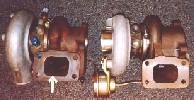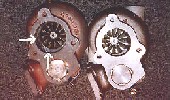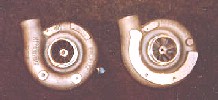Ok, enough rambling on. To cover the latest events first; at Alamo Autosports we just finished setting up our state-of-the-art Dynojet Chassis Dyno. The Dynojet is a revolutionary new "inertial wheel" dyno that can give a complete Horsepower and Torque graph from one 7 second run. Itís all computerized and will correct for altitude, temp, barometric pressure and humidity. You can even overlay up to 3 graphs on top of each other to compare runs. If you canít tell, I am slightly excited about our new ëtoyí. The accuracy is amazing, and you wouldnít believe the amount of information one can learn with the ability of producing back to back runs after making changes to the vehicle (yes, the ëStealthí is going to see some ëextendedí time on it!).
The boost creep problem has almost been solved by some extensive porting of the turbine housing around the inlet and wastegate (see picís). The wastegate can almost hold boost now in first and second gear. It still tends to creep in third and fourth, but itís not as dramatic and much more controllable (by throttle position) than before. An added bonus is the extra power found after the porting. Subjectively, the car feels as quick and eager at 6psi now as it did at 10+ psi before. Itís a very dramatic difference! I think the next step will be to disassemble the turbo again, perform additional porting around the wastegate opening and machine a new larger wastegate valve. In addition, a full 3" mandrel bent exhaust will be fabricated to fit in place of the 2.5" system now. I believe the further reduction in backpressure will do a lot towards totally stabilizing the boost.
The next upgrade (to be done in conjunction with the turbine work) will be the addition of a sport compressor housing (designated a "20G", stock is a "17C"). Dyno runs will be made before and after all mods if possible. While everything is apart, the exhaust manifold will receive some careful porting and polishing. Iíll probably wait to match the intake runners until I have a reason to pull the head and do it right. Everything possible will get ceramic coated though. This includes turbo, intake and exhaust manifolds, heat shields, and intercooler to throttle body inlet piping. Heat is energy, and itís proven the more heat (and thus energy) you can deliver to the turbo, the quicker the spool-up will be and the more power it will make.
With the above mods, I hope to gain around 40 to 50 hp at the flywheel, at the same boost pressure. The dyno will tell the real story, so weíll see how close I am. As I have said before, a key to the horsepower gains I expect to see, is the ability to custom tailor and modify the fuel and spark events with the Accel DFI fuel management computer. Being off the fuel curve just a ëlittleí can mean a LOT in horsepower - if not roasting an engine.
Expect lots of dyno graphs next month!



